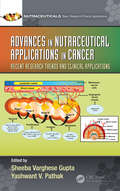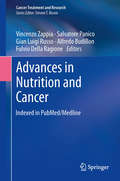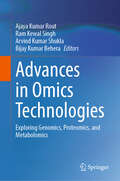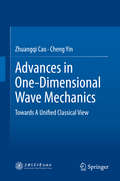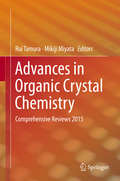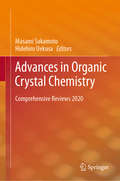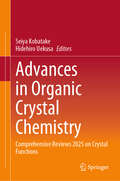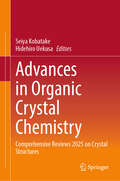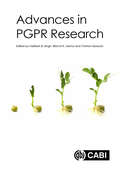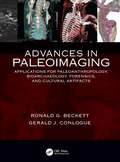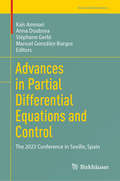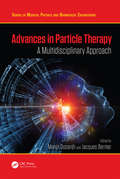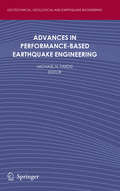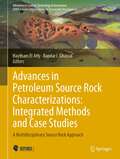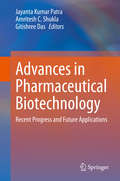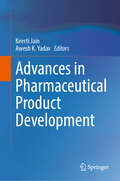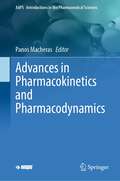- Table View
- List View
Advances in Numerical Heat Transfer, Volume 3 (Computational & Physical Processes in Mechanics & Thermal Scienc)
by W. J. MinkowyczDefinitive Treatment of the Numerical Simulation of Bioheat Transfer and Fluid FlowMotivated by the upwelling of current interest in subjects critical to human health, Advances in Numerical Heat Transfer, Volume 3 presents the latest information on bioheat and biofluid flow. Like its predecessors, this volume assembles a team of renowned internatio
Advances in Nutraceutical Applications in Cancer: Recent Research Trends and Clinical Applications (Nutraceuticals)
by Yashwant V. Pathak Sheeba Varghese GuptaDietary supplements and nutraceuticals such as Vitamin A and D, Omega-3 and probiotics are used as part of the cancer treatment as complimenting the main therapy. Several Nutraceuticals have shown to boost the immune responses, while emerging clinical studies and other research suggests that some plant-based agents may, indeed, impact late-stage cancer, influencing molecular processes corrupted by tumor cells to evade detection, expand clonally, and invade surrounding tissues. Advances in Nutraceutical Applications in Cancer: Recent Research Trends and Clinical Applications is an attempt to collect evidence and related clinical information of application of Nutraceuticals to be used in cancer treatment or compliment the cancer treatment. It contains 16 chapters written by experts in related field’s and covers many different aspects of the formulation and development of Nutraceuticals for cancer applications. This book covers efficacy, safety and toxicological aspects of nutraceuticals. It also addresses various novel drug delivery systems of nutraceuticals with anticancer properties, as well as nutraceuticals as supplements for cancer prevention. Features: Offers a comprehensive view of neutraceuticals’ role in cancer prevention and treatment Covers the applications and implications of neutraceuticals in prostate, colorectal, breast and gynecological cancers Discusses the principles of neutrigenomics and neutrigenetics in cancer prevention Explors the role of probiotics and micronutrients in cancer treatment and prevention Nutraceuticals can alter the gut microbiota. Gut microbiome undergoes changes during the disease status and followed by the cancer treatment. Nutraceutical’s role in proliferation and prevention of gynecological cancers, nutraceutical’s role in proliferation and prevention of prostate cancer and role of micronutrients in cancer prevention, both pros and cons, are some of the topics discussed in various chapters in this book. This book is addressed to scientists, clinicians, and students who are working in the area of Nutraceutical applications in cancer treatment.
Advances in Nutrition and Cancer (Cancer Treatment and Research #159)
by Vincenzo Zappia Salvatore Panico Gian Luigi Russo Alfredo Budillon Fulvio Della RagioneThis book comprises proceedings from the Third International Conference on Advances in Nutrition and Cancer, held in Naples in May 2012. This highly multidisciplinary meeting analyzed "nutrition and cancer" from different perspectives and on the basis of distinct and up-to-date experimental approaches. Knowledge on the relation between lifestyle, diet, and cancer is explored in a number of contributions, and the role of dietary intervention in cancer patients is discussed. Issues of vital interest to the research community, such as epidemiological and experimental oncology (genetics, epigenetics, and the mechanisms of action of natural compounds in the diet), receive detailed consideration. A further key topic is the emerging molecular technologies (the "omics") that can cast light on the interplay between nutrition and human malignancies. Chapters take the form of reviews that include sections presenting expert opinions.
Advances in Omics Technologies: Exploring Genomics, Proteomics, and Metabolomics
by Bijay Kumar Behera Ajaya Kumar Rout Ram Kewal Singh Arvind Kumar ShuklaThis comprehensive volume offers an in-depth exploration of the latest advancements in omics technologies and their practical applications across environmental science, agriculture, healthcare, and biotechnology. Covering key topics such as metagenomics for identifying beneficial microbes, bioremediation for environmental cleanup, bacteriophages, proteomics, epigenomics, and CRISPR-Cas9 genome editing, the book provides valuable insights into cutting-edge tools and methodologies. It also delves into next-generation sequencing, biosensor technology, bioinformatics tools, mass spectrometry-based metabolomics, as well as emerging fields like nutrigenomics and microarrays technology. With clear explanations and practical perspectives, this authoritative resource is ideal for students, researchers, and professionals striving to stay abreast of innovations in life sciences and contribute to the rapidly evolving landscape of omics sciences.
Advances in One-Dimensional Wave Mechanics: Towards A Unified Classical View
by Zhuangqi Cao Cheng YinAdvances in One-Dimensional Wave Mechanics provides a comprehensive description of the motion of microscopic particles in one-dimensional, arbitrary-shaped potentials based on the analogy between Quantum Mechanics and Electromagnetism. Utilizing a deeper understanding of the wave nature of matter, this book introduces the concept of the scattered sub-waves and a series of new analytical results using the Analytical Transfer Matrix (ATM) method. This work will be useful for graduate students majoring in physics, mainly in basic quantum theory, as well as for academic researchers exploring electromagnetism, particle physics, and wave mechanics and for experts in the field of optical waveguide and integrated optics. Prof. Zhuangqi Cao is a Professor of Physics at Shanghai Jiao Tong University, China. Dr. Cheng Yin is a teacher at Jiangsu Key Laboratory of Power Transmission and Distribution Equipment Technology, Hohai University, China.
Advances in Open Systems and Fundamental Tests of Quantum Mechanics: Proceedings of the 684. WE-Heraeus-Seminar, Bad Honnef, Germany, 2–5 December 2018 (Springer Proceedings in Physics #237)
by Bassano Vacchini Heinz-Peter Breuer Angelo BassiQuantum mechanics has shown unprecedented success as a physical theory, but it has forced a new view on the description of physical reality. In recent years, important progress has been achieved both in the theory of open quantum systems and in the experimental realization and control of such systems. A great deal of the new results is concerned with the characterization and quantification of quantum memory effects. From this perspective, the 684. WE-Heraeus-Seminar has brought together scientists from different communities, both theoretical and experimental, sharing expertise on open quantum systems, as well as the commitment to the understanding of quantum mechanics. This book consists of many contributions addressing the diversified physics community interested in foundations of quantum mechanics and its applications and it reports about recent results in open quantum systems and their connection with the most advanced experiments testing quantum mechanics.
Advances in Optical Imaging for Clinical Medicine (Wiley Series in Biomedical Engineering and Multi-Disciplinary Integrated Systems #6)
by Nicusor Iftimia William R. Brugge Daniel X. HammerThis book provides students, teachers, researchers and clinicians with a strong and established source of information on advanced optical technologies that show real promise of being translated to clinical use.
Advances in Orchid Biology, Biotechnology and Omics
by Jen-Tsung Chen Pragya TiwariThis book provides comprehensive insights into the existing and emerging trends in orchid biology based on the findings of omics, high-throughput technology, biotechnology, molecular breeding, and genome editing approaches in orchids. It illustrates molecular mechanisms of orchid mycorrhizal symbiosis according to the recent achievements of transcriptomics and bioinformatics studies which accelerate the progress of orchid research with the aid of their high-throughput tools. In this book, a comprehensive view of orchid breeding was presented, and it includes fundamental methods as well as advanced strategies through the combination of several technologies such as genetic engineering, omics, computational biology, and genome editing. These resulting knowledge and tools are highly beneficial for obtaining novel and fascinating varieties in the orchid market which is a competitive industry of global trade. Another interesting content is the focus on the production of orchid bioactive compounds and their values in the field of ethnomedicine. Their sources chiefly came from secondary metabolites and can be enriched through elicitors and produced more efficiently by improved tissue culture protocols and bioreactors. In this edited collection, we provided space for presenting an updated review of in vitro seed germination which is a routine technology for well-trained researchers but can give a complete demonstration for the potential audiences including growers and research beginners. This book collects refined knowledge from a broad source of scientific literature by experts in the field of orchid research and surely is an adequate reference and textbook for students, teachers, and researchers. It includes methods and applications of orchid breeding technology which would gain high attention from growers, breeders, and the related fields of agriculture.
Advances in Organic Crystal Chemistry: Comprehensive Reviews 2015
by Rui Tamura Mikiji MiyataFor the last decade, the topics of organic crystal chemistry have become diversified, and each topic has been substantially advanced in concert with the rapid development of various analytical and measurement techniques for solid-state organic materials. The aim of this book is to systematically summarize and record the recent notable advances in various topics of organic crystal chemistry involving liquid crystals and organic-inorganic hybrid materials that have been achieved mainly in the last 5 years or so. The authors are invited members of the Division of Organic Crystals, The Chemical Society of Japan (CSJ), and prominent invited experts from abroad. This edited volume is planned to be published periodically, at least every 5 years, with contributions by prominent authors in Japan and from abroad.
Advances in Organic Crystal Chemistry: Comprehensive Reviews 2020
by Masami Sakamoto Hidehiro UekusaThis book summarizes and records the recent notable advances in diverse topics in organic crystal chemistry, which has made substantial progress along with the rapid development of a variety of analysis and measurement techniques for solid organic materials. This review book is one of the volumes that are published periodically on this theme. The previous volume, published in 2015, systematically summarized the remarkable progress in assorted topics of organic crystal chemistry using organic solids and organic–inorganic hybrid materials during the previous 5 years, and it has been widely read. The present volume also shows the progress of organic solid chemistry in the last 5 years, with contributions mainly by invited members of the Division of Organic Crystal Chemistry of the Chemical Society of Japan (CSJ), together with prominent invited authors from countries other than Japan.
Advances in Organic Crystal Chemistry: Comprehensive Reviews 2025 on Crystal Functions
by Hidehiro Uekusa Seiya KobatakeThis book summarizes and records the recent notable advances in diverse topics in organic crystal chemistry, which has made substantial progress along with the rapid development of a variety of analysis and measurement techniques for solid organic materials. This volume follows previously published volumes that are prepared periodically, at least every 5 years, with contributions by prominent authors in Japan and from abroad. The first volume was published in 2015, which systematically summarized the remarkable progress in assorted topics of organic crystal chemistry using organic solids and organic–inorganic hybrid materials. The second volume, published in 2020, presented advances in organic solid-state chemistry mainly from 2016 to 2020. The present volume also shows the progress of organic solid-state, especially focusing on crystalline functional materials with mechanical, luminescent, electrical and magnetic properties that have been achieved mainly in the last 5 years or so. The topics that this book dealt with, which have been rapidly developed in the last decade, will be of interest not only to researchers of organic crystals but also to those in photochemistry, materials chemistry molecular science and applied physics.
Advances in Organic Crystal Chemistry: Comprehensive Reviews 2025 on Crystal Structures
by Hidehiro Uekusa Seiya KobatakeThis book summarizes and records the recent notable advances in diverse topics in organic crystal chemistry, which has made substantial progress along with the rapid development of a variety of analysis and measurement techniques for solid organic materials. This volume follows previously published volumes that are prepared periodically, at least every 5 years, with contributions by prominent authors in Japan and from abroad. The first volume was published in 2015, which systematically summarized the remarkable progress in assorted topics of organic crystal chemistry using organic solids and organic–inorganic hybrid materials. The second volume, published in 2020, presented advances in organic solid-state chemistry mainly from 2016 to 2020. The present volume also shows the progress of organic solid-state chemistry, especially focusing on crystal growth and crystal structure design that has been achieved mainly in the last 5 years or so. Crystal growth and crystal structure design described in this book is helpful for not only readers who study organic crystals but also those who study inorganic crystals, materials chemistry, coordination chemistry, and organometallic chemistry.
Advances in Organometallic Chemistry and Catalysis
by Armando J. PombeiroA contemporary compilation of recent achievements in organometallic chemistryThe prestigious International Conference on Organometallic Chemistry (ICOMC) was launched in 1963, providing a forum for researchers from around the world to share their findings and explore new paths to advance our knowledge and application of organometallic chemistry. The 25th ICOMC, held in Lisbon in 2012, gathered more than 1,200 participants from 54 countries. This volume celebrates the 25th Silver Edition and the 50th Gold Year of the ICOMC.Featuring contributions from invited 25th ICOMC speakers, Advances in Organometallic Chemistry and Catalysis highlights recent achievements and new and emerging areas of research in the field. Its seven sections cover:Activation and Functionalization of Carbon Single Bonds and Small MoleculesOrganometallic Synthesis and CatalysisOrganometallic Polymerization CatalysisOrganometallic Polymers and MaterialsOrganometallic Chemistry and Sustainable EnergyBioorganometallic ChemistryOrganometallic ElectrochemistryChapters discuss fundamental underlying concepts, offer illustrative examples and cases, and explore future avenues for continued research. Readers will discover basic principles and properties of organometallic compounds, reaction mechanisms, and detailed descriptions of current applications. Collectively, these chapters underscore the versatility, richness, and potential of modern organometallic chemistry, including its interrelationships with other scientific disciplines.All the contributions are extensively referenced, providing a gateway to the most important original research papers and reviews in organometallic chemistry. Presenting a contemporary understanding of organometallic chemistry and its many applications, Advances in Organometallic Chemistry and Catalysis is recommended for all researchers in the field, from students to advanced investigators.
Advances in PGPR Research
by Virendra S. Bisaria Randy Ortiz-Castro Robert Hill Jose López-Bucio Madhu Kamle Pradeep Kumar Dubey Rama Kant Dubey Kartikay Bisen Dr Chetan Keswani P. C. Abhilash Betina Cecilia Agaras Gautam Anand Laith K. Al-Ani Fabiola Padilla Arizmendi Fatima Berenice Salazar-Badillo Mansi Bakshi E. J. Bedmar Adrien Biessy Marieta Marin Bruzos Jesús Salvador López-Bucio Jorge Armando Mauricio-Castillo Vasvi Chaudhry Niladri Chaudhry Manoj Kumar Chitara Pooja Choudhary Manish Kumar Dubey Sheikh Adil Edirisi Martin Filion Elisabetta Franchi Deepika Goyal Natalia Cripps-Guazzone Antonio Castellano-Hinojosa Angela Cristina Ikeda María Fernanda Nieto-Jacobo Diwakar Kandula Gagan Kumar Punam Kumari Richard Daniel Lally Robert Lawry Guillermo Nogueira-López Anupam Maharshi Shrikant S. Mantri Rafael Jorge Marcillo Dmitri V. MavrodiRhizosphere biology is approaching a century of investigations wherein growth-promoting rhizomicroorganisms (PGPR) have attracted special attention for their ability to enhance productivity, profitability and sustainability at a time when food security and rural livelihood are a key priority. Bio-inputs - either directly in the form of microbes or their by-products - are gaining tremendous momentum and harnessing the potential of agriculturally important microorganisms could help in providing low-cost and environmentally safe technologies to farmers.One approach to such biologically-based strategies is the use of naturally occurring products such as PGPR. Advances in PGPR Research explores recent developments and global issues in biopesticide research, presented via extended case studies and up-to-date coverage of: · Low input biofertilizers and biofungicides used for sustainable agriculture. · Molecular techniques to enhance efficacy of microbial inputs. · Intellectual property issues in PGPR research. Written by an international team of experts, this book considers new concepts and global issues in biopesticide research and evaluates the implications for sustainable productivity. It is an invaluable resource for researchers in applied agricultural biotechnology, microbiology and soil science, and also for industry personnel in these areas.
Advances in PGPR Research
by Harikesh B. Singh Chetan Keswani Birinchi K. SarmaRhizosphere biology is approaching a century of investigations wherein growth-promoting rhizomicroorganisms (PGPR) have attracted special attention for their ability to enhance productivity, profitability and sustainability at a time when food security and rural livelihood are a key priority. Bio-inputs - either directly in the form of microbes or their by-products - are gaining tremendous momentum and harnessing the potential of agriculturally important microorganisms could help in providing low-cost and environmentally safe technologies to farmers. One approach to such biologically-based strategies is the use of naturally occurring products such as PGPR. Advances in PGPR Research explores recent developments and global issues in biopesticide research, presented via extended case studies and up-to-date coverage of: #65533; Low input biofertilizers and biofungicides used for sustainable agriculture. #65533; Molecular techniques to enhance efficacy of microbial inputs. #65533; Intellectual property issues in PGPR research. Written by an international team of experts, this book considers new concepts and global issues in biopesticide research and evaluates the implications for sustainable productivity. It is an invaluable resource for researchers in applied agricultural biotechnology, microbiology and soil science, and also for industry personnel in these areas.
Advances in Paleoimaging: Applications for Paleoanthropology, Bioarchaeology, Forensics, and Cultural Artefacts
by Ronald G. Beckett Gerald J. ConlogueAdvances in Paleoimaging: Applications for Paleoanthropology, Bioarchaeology, Forensics, and Cultural Artifacts builds on the research and advances in technology since the writing of the authors’ first book, Paleoimaging: Field Applications for Cultural Remains and Artifacts (ISBN: 978-1-4200-9071-0). Since Paleoimaging was published in 2009, additional research settings for the application of advanced imaging technologies have been identified. Practices are now more widespread and standardized with the capabilities and utilization of imaging methodologies increasing dramatically. Given the numerous advances in paleoimaging technique and technology, this book chronicles the evolution that has taken place in all the imaging modalities. Chapters include the coverage of magnetic resonance imaging, computed tomography, plane and digital radiography, endoscopy, and applications of x-ray fluorescence, as well as the principles of industrial radiography. While the book focuses on a multimodal imaging approach to anthropological and archaeological research, the authors and contributing authors have vast experience in other areas and present coverage of biological applications as well. The multidisciplinary chapters provide a foundation to understand the application of various imaging modalities in archaeological, anthropological, bioanthropological, and forensic settings. As such, Advances in Paleoimaging will serve as an essential reference for conservators, museum archivists, forensic anthropologists, paleopathologists, and archaeologists, who perform non-destructive research on historical or culturally significant artifacts, remains, or material from a forensic investigation. The concepts and methods presented in this text are supported with case presentations of the authors' vast experience in the new companion book, Case Studies for Advances in Paleoimaging (ISBN: 978-0-367-25166-6) by Beckett, Conlogue, and Nelson (2020).
Advances in Partial Differential Equations and Control: The 2023 Conference in Seville, Spain (Trends in Mathematics)
by Kaïs Ammari Stéphane Gerbi Anna Doubova Manuel González-BurgosThis volume presents a timely overview of control theory and related topics, such as the reconstruction problem, the stability of PDEs, and the Calderón problem. The chapters are based on talks given at the conference "Control & Related Fields” held in Seville, Spain in March 2023. In addition to providing a snapshot of these areas, chapters also highlight breakthroughs on more specific topics, such as:Stabilization of an acoustic systemThe Kramers-Fokker-Planck operatorControl of parabolic equationsControl of the wave equationAdvances in Partial Differential Equations and Control will be a valuable resource for both established researchers as well as more junior members of the community.
Advances in Particle Therapy: A Multidisciplinary Approach (Series in Medical Physics and Biomedical Engineering)
by Jacques Bernier Manjit DosanjhHadron therapy is a groundbreaking new method of treating cancer. Boasting greater precision than other therapies, this therapy is now utilised in many clinical settings and the field is growing. More than 50 medical facilities currently perform (or are planned to perform) this treatment, with this number set to double by 2020. This new text covers the most recent advances in hadron therapy, exploring the physics, technology, biology, diagnosis, clinical applications, and economics behind the therapy. Providing essential and up-to-date information on recent developments in the field, this book will be of interest to current and aspiring specialists from a wide range of backgrounds. Features: Multidisciplinary approach: explores the physics, IT (big data), biology, clinical applications from imaging to treatment, clinical trials, and economics associated with hadron therapy Contains the latest research and developments in this rapidly evolving field, and integrates them into the current global challenges for radiation therapy Edited by recognised leaders in the field, including the co-ordinator of ENLIGHT (the European Network for Light Ion Hadron Therapy), with chapter contributions from international leading experts in the field
Advances in Performance-Based Earthquake Engineering (Geotechnical, Geological and Earthquake Engineering #13)
by Michael N. FardisPerformance-based Earthquake Engineering has emerged before the turn of the century as the most important development in the field of Earthquake Engineering during the last three decades. It has since then started penetrating codes and standards on seismic assessment and retrofitting and making headway towards seismic design standards for new structures as well. The US have been a leader in Performance-based Earthquake Engineering, but also Europe is a major contributor. Two Workshops on Performance-based Earthquake Engineering, held in Bled (Slovenia) in 1997 and 2004 are considered as milestones. The ACES Workshop in Corfu (Greece) of July 2009 builds on them, attracting as contributors world-leaders in Performance-based Earthquake Engineering from North America, Europe and the Pacific rim (Japan, New Zealand, Taiwan, China). It covers the entire scope of Performance-based Earthquake Engineering: Ground motions for performance-based earthquake engineering; Methodologies for Performance-based seismic design and retrofitting; Implementation of Performance-based seismic design and retrofitting; and Advanced seismic testing for performance-based earthquake engineering. Audience: This volume will be of interest to scientists and advanced practitioners in structural earthquake engineering, geotechnical earthquake engineering, engineering seismology, and experimental dynamics.
Advances in Personalized Nanotherapeutics
by Ajeet Kaushik Rahul Dev Jayant Madhavan NairPersonalized health care to manage diseases and optimized treatment is crucial for everyone to maintain health quality. Significant efforts have been made to design and develop novel nano-enabling therapeutic strategies to cure and monitor diseases for personalized health care. As state-of-the-art, various strategies have been reported to develop personalized nanomedicine to combat against target diseases with no side effects. In this book proposal, we are trying to describe fundamentals of personalized nanomedicine, novel nanomaterials for drug delivery, role of nanotechnology for efficient therapeutics approach, nano-pharmacology, targeted CNS drug delivery, stimuli responsive drug release and nanotechnology for diseases management. This book would serve as a platform for new scholars to understand state-of-the-art of nanotechnology for therapeutics and designing their future research to develop effective personalized nanomedicine against targeted diseases. As of now, various studies have been reported to design and develop nanomedicines of higher efficacy but unfortunately, such products are up to laboratory research only and need to be well-tested using pre-clinical or human models. Our book would be a call for experts to explore multidisciplinary research for developing novel and efficient approaches to explore smart efficient nanocarriers for site-specific on-demand controlled drug delivery to combat against targeted diseases to personalized health care.
Advances in Petrochemical Engineering and Green Development: Proceedings of the 3rd International Conference on Petrochemical Engineering and Green Development (ICPEGD 2022), Shanghai, China, 25-27 February 2022
by Bin GuanAdvances in Petrochemical Engineering and Green Development is a compilation of selected papers from the 3rd International Conference on Petrochemical Engineering and Green Development (ICPEGD 2022) and focuses on the research of petrochemical engineering. The proceedings features the most cutting-edge research directions and achievements related to geology and green development. Subjects in this proceedings include: Petroleum and Petrochemical Engineering Fossil Technologies Oil & Gas Production Renewable Energy Sources and Technology Green Synergy Innovation Urban Crisis Management The collection of papers in this proceedings will promote the development of petrochemical industry and energy, resource sharing, flexibility and high efficiency. Thereby, it will promote scientific information interchange between scholars from top universities, research centers and high-tech enterprises working all around the world.
Advances in Petroleum Source Rock Characterizations: A Multidisciplinary Source Rock Approach (Advances in Science, Technology & Innovation)
by Haytham El Atfy Bandar I. GhassalThis book is directed to those who are interested in petroleum geology, especially source rock from both academia and industrial societies. Our chapter-based book is written by a list of world-class subject-matter experts.The book includes recent advancements in analytical source rock characterization methods with some case studies. It is also used as part of a course curriculum or guide for source rock interpretation for all researcher categories.Significant improvement in the source rock characterization techniques in the last two decades and the knowledge is disseminated in a huge amount of papers and studies. The book intends to collect these recent advancements in one textbook to benefit students and researchers in general. In addition, it is supplemented by many case studies from all over the world that represent important data sets for the regional geology of these areas.
Advances in Pharmaceutical Biotechnology: Recent Progress and Future Applications
by Jayanta Kumar Patra Gitishree Das Amritesh C. ShuklaThis book explains both the basic science and the applications of biotechnology-derived pharmaceuticals, with special emphasis on their clinical uses. The foundations of pharmaceutical biotechnology lie mainly in the capability of plants, microorganism, and animals to produce low and high molecular weight compounds useful as therapeutics. Pharmaceutical biotechnology has flourished since the advent of recombinant DNA technology and metabolic engineering, supported by the well-developed bioprocess technology. A large number of monoclonal antibodies and therapeutic proteins have been approved, delivering meaningful contributions to patients’ lives, and the techniques of biotechnology are also a driving force in modern drug discovery. Due to this rapid growth in the importance of biopharmaceuticals and the techniques of biotechnologies to modern medicine and the life sciences, the field of pharmaceutical biotechnology has become an increasingly important component in the education of pharmacists and pharmaceutical scientists. This book will serve as a complete one-stop source on the subject for undergraduate and graduate pharmacists, pharmaceutical science students, and pharmaceutical scientists in industry and academia.
Advances in Pharmaceutical Product Development
by Keerti Jain Awesh K. YadavThis book discusses the stages involved in pharmaceutical product development including the importance, requirement, and effect of each stage and process. It also covers prototype development for pharmaceutical formulations, scale-up studies, optimization, testing, packaging, and commercialization of different dosage forms for pharmaceutical products like tablets, suspensions, emulsions, coating, inhalational products, sterile products, and herbal formulations. The book also presents advancements in tablet production and tablet coating, including materials, material handling, granulation and granulation technologies, process automation, processing problems in tablet production and troubleshooting, advances in equipment for coating and coating materials. Further, the chapter explores the advances in the formulation and development of aerosols, nebulizers, inhalers, metered Dose Inhalers (MDI), and dry powder Inhalers (DPIs). Towards the end, the book examines the challenges, formulation development, testing, stability, and regulatory guidelines in the development of herbal formulations. This book provides a valuable source of information for the researcher, scientists, students, and people working in the area mainly focused on the challenges in pharmaceutical product development.
Advances in Pharmacokinetics and Pharmacodynamics (AAPS Introductions in the Pharmaceutical Sciences #9)
by Panos MacherasThis book provides a concise overview of recent advances in Pharmacokinetics (PK) and Pharmacodynamics (PD). The pharmacokinetics section covers the state of the art in Physiologically Based Pharmacokinetic (PBPK) modeling (Chapter 1) as well as the assessment of food effect on drug absorption using PBPK modeling (Chapter 2). Chapters 3 and 4 describe the recent development of Physiologically Based Finite Time Pharmacokinetic (PBFTPK) models and their applications to pharmacokinetic data. The pharmacodynamics section focuses on PK/PD modeling. Chapter 5 provides an overview of PK/PD modeling and simulation in clinical practice and studies. Chapter 6 deals with the subject/physiology variability issue encountered in PK/PD studies, while Chapter 7 reviews the influence of clinical pharmacology in the modernization of drug development and regulation. This book is an essential reference for pharmaceutical scientists.

